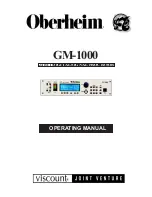
OPTIMOD-TV DIGITAL
OPERATION
3-25
system gain reduction determines how much the loudness of quiet passages will be
increased (and, therefore, how consistent overall loudness will be). It is determined
by the setting of the
AGC
D
RIVE
control, by the level at which the console VU meter
or PPM is peaked, and by the setting of the
M
ULTIBAND
D
RIVE
(compressor) control.
AGC REL
(“AGC Master Release”) control provides an adjustable range from 0.5
dB/second (slow) to 20 dB/second (fast). The increase in density caused by setting the
AGC
R
ELEASE
control to fast settings sounds different from the increase in density
caused by setting the Multiband’s
M
ULTIBAND
R
ELEASE
control to
F
AST
, and you can
trade the two off to produce different effects.
Unless it is purposely speeded-up (with the
AGC
R
ELEASE
control), the automatic
gain control (AGC) that occurs in the AGC prior to the multiband compressor makes
audio levels more consistent without significantly altering texture. Then the multi-
band compression and associated multiband clipper audibly change the density of
the sound and dynamically re-equalize it as necessary (booming bass is tightened;
weak, thin bass is brought up; highs are always present and consistent in level).
The various combinations of AGC and compression offer great flexibility:
Light AGC + light compression yields a wide sense of dynamics, with a small
amount of automatic re-equalization.
Moderate AGC + light compression produces an open, natural quality with
automatic re-equalization and increased consistency of frequency balance.
Moderate AGC + moderate compression gives a more dense sound, particularly
as the release time of the multiband compressor is sped up.
Moderate AGC + heavy compression (particularly with a
FAST
multiband release
time) results in a “wall of sound” effect, which may cause listener fatigue.
Adjust the AGC (with the
AGC
D
RIVE
control) to produce the desired amount of
AGC action, and then fine-tune the compression and clipping with the Five-Band
structure’s controls.
AGC GATE
(“AGC Gate Threshold”) control determines the lowest input level that
will be recognized as program by OPTIMOD-TV; lower levels are considered to be
noise or background sounds and cause the AGC or multiband compressor to gate,
effectively freezing gain to prevent noise breathing.
In television audio, the setting of the gate threshold
controls are quite critical if you
want the processing to be undetectable to the audience. If this control is set too
low, then the 8382 will pump up quiet sounds such as ambience and underscoring to
unnaturally high levels.
There are two independent silence-gating circuits in the 8382. The first affects the
AGC
and the second affects the
multiband compressor
. Each has its own thresh-
old control.
Summary of Contents for Optimod-TV 8382
Page 22: ......
Page 108: ......
Page 162: ......
Page 174: ......
Page 213: ...OPTIMOD TV DIGITAL TECHNICAL DATA 6 25...
Page 219: ...OPTIMOD TV DIGITAL TECHNICAL DATA 6 31 CPU Module...
Page 225: ...OPTIMOD TV DIGITAL TECHNICAL DATA 6 37 RS232 BOARD PARTS LOCATOR...
Page 227: ...OPTIMOD TV DIGITAL TECHNICAL DATA 6 39 POWER SUPPLY PARTS LOCATOR...
Page 229: ...OPTIMOD TV DIGITAL TECHNICAL DATA 6 41 8382 I O Board Parts Locator...
Page 234: ...6 46 TECHNICAL DATA ORBAN MODEL 8382 DSP BOARD PARTS LOCATOR DRAWING 32170 000 14...
Page 242: ...6 54 TECHNICAL DATA ORBAN MODEL 8382 DISPLAY BOARD PARTS LOCATOR...
Page 243: ...OPTIMOD TV DIGITAL TECHNICAL DATA 6 55 DISPLAY BOARD...
















































